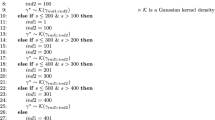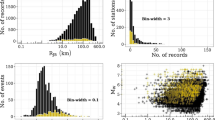Abstract
In probabilistic seismic hazard analysis, different ground-motion prediction equations (GMPEs) are commonly combined within a logic tree framework. The selection of appropriate GMPEs, however, is a non-trivial task, especially for regions where strong motion data are sparse and where no indigenous GMPE exists because the set of models needs to capture the whole range of ground-motion uncertainty. In this study we investigate the aggregation of GMPEs into a mixture model with the aim to infer a backbone model that is able to represent the center of the ground-motion distribution in a logic tree analysis. This central model can be scaled up and down to obtain the full range of ground-motion uncertainty. The combination of models into a mixture is inferred from observed ground-motion data. We tested the new approach for Northern Chile, a region for which no indigenous GMPE exists. Mixture models were calculated for interface and intraslab type events individually. For each source type we aggregated eight subduction zone GMPEs using mainly new strong-motion data that were recorded within the Plate Boundary Observatory Chile project and that were processed within this study. We can show that the mixture performs better than any of its component GMPEs, and that it performs comparable to a regression model that was derived for the same dataset. The mixture model seems to represent the median ground motions in that region fairly well. It is thus able to serve as a backbone model for the logic tree.






Similar content being viewed by others
References
Abrahamson NA, Silva WJ (1997) Empirical response spectral attenuation relations for shallow crustal earthquakes. Seismol Res Lett 68(1):94–127
Abrahamson NA, Youngs RR (1992) A stable algorithm for regression analyses using the random effects model. Bull Seismol Soc Am 82(1):505–510
Akkar S, Bommer JJ (2006) Influence of long-period filter cut-off on elastic spectral displacements. Earthq Eng Struct Dyn 35(9):1145–1165
Akkar S, Kale O, Yenier E, Bommer JJ (2011) The high-frequency limit of usable response spectral ordinates from filtered analogue and digital strong-motion accelerograms. Earthq Eng Struct Dyn 40(12):1387–1401
Arango MC, Strasser FO, Bommer JJ, Boroschek R, Comte D, Tavera H (2011) A strong-motion database from the Peru–Chile subduction zone. J Seismol 15(1):19–41
Arroyo D, García D, Ordaz M, Mora MA, Singh SK (2010) Strong ground-motion relations for Mexican interplate earthquakes. J Seismol 14(4):769–785
Atkinson GM (2006) Single-station sigma. Bull Seismol Soc Am 96(2):446–455
Atkinson GM, Boore DM (2003) Empirical ground-motion relations for subduction zone earthquakes and their application to Cascadia and other regions. Bull Seismol Soc Am 93(4):1703–1729
BC Hydro (2012). Probabilistic seismic hazard analysis (PSHA) model. BC Hydro Engineering Report E658, vol. 1–4, November 2012
Beyer K, Bommer JJ (2006) Relationships between median values and between aleatory variabilities for different definitions of the horizontal component of motion. Bull Seismol Soc Am 96(4A):1512–1522
Blaser L, Krüger F, Ohrnberger M, Scherbaum F (2010) Scaling relations of earthquake source parameter estimates with special focus on subduction environment. Bull Seismol Soc Am 100(6):2914–2926
Bommer JJ, Scherbaum F, Bungum H, Cotton F, Sabetta F, Abrahamson NA (2005) On the use of logic trees for ground-motion prediction equations in seismic-hazard analysis. Bull Seismol Soc Am 95(2):377–389
Bommer JJ, Douglas J, Scherbaum F, Cotton F, Bungum H, Fäh D (2010) On the selection of ground-motion prediction equations for seismic hazard analysis. Seismol Res Lett 81(5):783–793
Bommer JJ, Coppersmith KJ, Coppersmith RT, Hanson KL, Mangongolo A, Neveling J, Rathje EM, Rodriguez-Marek A, Scherbaum F, Shelembe R, Stafford PJ, Strasser FO (2013) A SSHAC Level 3 probabilistic seismic hazard analysis for a new-build nuclear site in South Africa. Earthq Spectra. doi:10.1193/060913EQS145M
Boore DM (2005) On pads and filters: processing strong-motion data. Bull Seismol Soc Am 95(2):745–750
Boore DM, Bommer JJ (2005) Processing of strong-motion accelerograms: needs, options and consequences. Soil Dyn Earthq Eng 25(2):93–115
Bragato PL, Slejko D (2005) Empirical ground-motion attenuation relations for the Eastern Alps in the magnitude range 2.5–6.3. Bull Seismol Soc Am 95(1):252–276
Budnitz RJ, Apostolakis G, Boore DM, Cluff LS, Coppersmith KJ, Cornell CA, Morris PA (1997) Recommendations for probabilistic seismic hazard analysis: guidance on uncertainty and use of experts. Technical Report NUREG/CR-6372
Comte D, Pardo M (1991) Reappraisal of great historical earthquakes in the Northern Chile and Southern Peru seismic gaps. Nat Hazards 4:23–44
Contreras V, Boroschek R (2012) Strong ground motion attenuation relations for Chilean subduction zone interface earthquakes. In: Proceedings of 15th world conference on earthquake engineering (15WCEE), Lisbon, Portugal
Converse AM, Brady AG (1992) BAP: basic strong-motion accelerogram processing software; Version 1.0. U.S. Geological Survey Open-File, Report 92-296A
Cotton F, Scherbaum F, Bommer JJ, Bungum H (2006) Criteria for selecting and adjusting ground-motion models for specific target regions: application to Central Europe and rock sites. J Seismol 10(2):137–156
Delouis B, Cisternas A, Dorbath L, Rivera L, Kausel E (1996) The Andean subduction zone between \(22^{\circ }\) and \(25^{\circ }\text{ S }\) (Northern Chile): precise geometry and state of stress. Tectonophysics 259:81–100
Dempster AP, Laird NM, Rubin DB (1977) Maximum likelihood from incomplete data via the EM algorithm. J R Stat Soc B Met 39(1):1–38
Douglas J (2011) Ground-motion prediction equations 1964–2010. Technical Report BRGM/RP-59356-FR
Douglas J, Boore DM (2011) High-frequency filtering of strong-motion records. Bull Earthq Eng 9(2):395–409
Douglas J, Cotton F, Di Alessandro C, Boore DM, Abrahamson NA, Akkar S (2012) Compilation and critical review of GMPEs for the GEM-PEER Global GMPEs Project. In: Proceedings of the 15th world conference on earthquake engineering (15WCEE), Lisbon, Portugal
Frühwirth-Schnatter S (2006) Finite mixture and Markov switching models. Springer Series in Statistics. Springer, New York
García D, Singh SK, Herráiz M, Ordaz M, Pacheco JF (2005) Inslab earthquakes of Central Mexico: peak ground-motion parameters and response spectra. Bull Seismol Soc Am 95(6):2272–2282
Hanks TC, Abrahamson NA, Boore DM, Coppersmith KJ, Knepprath NE (2009) Implementation of the SSHAC guidelines for Level 3 and 4 PSHAs—experience gained from actual applications. U.S. Geological Survey Open-File, Report 2009-1093, 66 p
Kale O, Akkar S (2013) A new procedure for selecting and ranking ground-motion prediction equations (GMPEs): the Euclidean distance-based ranking (EDR) method. Bull Seismol Soc Am 103(2A):1069–1084
Kanno T, Narita A, Morikawa N, Fujiwara H, Fukushima Y (2006) A new attenuation relation for strong ground motion in Japan based on recorded data. Bull Seismol Soc Am 96(3):879–897
Lin PS, Lee CT (2008) Ground-motion attenuation relationships for subduction-zone earthquakes in Northeastern Taiwan. Bull Seismol Soc Am 98(1):220–240
McVerry GH, Zhao JX, Abrahamson NA, Somerville PG (2006) New Zealand acceleration response spectrum attenuation relations for crustal and subduction zone earthquakes. Bull N Z Soc Earthq Eng 39(1):1–58
National Earthquake Hazards Reduction Program (NEHRP) (1997) Recommended provisions for seismic regulations for new buildings and other structures. Technical Report Fema 302, U.S. Federal Emergency Management Agency, Washington, DC
Peyrat S, Madariaga R, Buforn E, Campos J, Asch G, Vilotte JP (2010) Kinematic rupture process of the 2007 Tocopilla earthquake and its main after-shocks from teleseismic and strong-motion data. Geophys J Int 182(3):1411–1430
Riggelsen C, Gianniotis N, Scherbaum F (2011) Learning aggregations of ground motion models from data. In: International conference on applications of statistics and probability in civil engineering, ICASP’11. Proceedings and monographs in engineering, water and Earth sciences. Taylor and Francis Group/CRC Press, pp 721–728
Rodriguez-Marek A, Rathje EM, Stafford PJ, Scherbaum F, Bommer JJ (2014) Application of site response analyses and single station sigma in seismic hazard analysis of the Thyspunt nuclear site in South Africa. Bull Seismol Soc Am 104(4) doi:10.1785/0120130196
Scherbaum F, Kuehn NM (2011) Logic tree branch weights and probabilities: summing up to one is not enough. Earthq Spectra 27(4):1237–1251
Scherbaum F, Cotton F, Smit P (2004a) On the use of response spectral-reference data for the selection and ranking of ground-motion models for seismic-hazard analysis in regions of moderate seismicity: the case of rock motion. Bull Seismol Soc Am 94(6):2164–2185
Scherbaum F, Schmedes J, Cotton F (2004b) On the conversion of source-to-site distance measures for extended earthquake source models. Bull Seismol Soc Am 94(3):1053–1069
Scherbaum F, Delavaud E, Riggelsen C (2009) Model selection in seismic hazard analysis: an information-theoretic perspective. Bull Seismol Soc Am 99(6):3234–3247
Scherbaum F, Kuehn NM, Ohrnberger M, Koehler A (2010) Exploring the proximity of ground-motion models using high-dimensional visualization techniques. Earthq Spectra 26(4):1117–1138
Schurr B, Asch A, Sodoudi F, Manzanares A, Ritter O, Klotz J, Chong-Diaz G, Barrientos S, Villotte JP, Oncken O (2009) The International Plate Boundary Observatory Chile (IPOC) in the Northern Chile seismic gap. In: EGU General Assembly, Vienna, Austria
Shakal AF, Boore D, Chiou BSJ, Iwan WD, O’Connell DR (2005) Guidelines and recommendations for strong-motion record processing and commentary. COSMOS, Publication No. CP-2005/01
Strasser FO, Arango MC, Bommer JJ (2010) Scaling of the source dimensions of interface and intraslab subduction-zone earthquakes with moment magnitude. Seismol Res Lett 81(6):941–950
Titterington DM, Smith AFM, Makov UE (1985) Statistical analysis of finite mixture distributions. Wiley Series in Probability and Statistics. Wiley, New York
USNRC (2012) Practical implementation guidelines for SSHAC Level 3 and 4 hazard studies. NUREG 2117, US Nuclear Regulatory Commission, Washingthon, DC
Wang R, Schurr B, Milkereit C, Shao Z, Jin M (2011) An improved automatic scheme for empirical baseline correction of digital strong-motion records. Bull Seismol Soc Am 101(5):2029–2044
Weber B (2002) Tragwerksdynamik. Lecture Notes, ETH Zürich, Abteilung für Bauingenieurwesen, Institut für Baustatik und Konstruktion (in German), doi:10.3929/ethz-a-004375919
Wells DL, Coppersmith KJ (1994) New empirical relationships among magnitude, rupture length, rupture width, rupture area, and surface displacement. Bull Seismol Soc Am 84(4):974–1002
Youngs RR, Chiou BSJ, Silva WJ, Humphrey JR (1997) Strong ground motion attenuation relationships for subduction zone earthquakes. Seismol Res Lett 68(1):58–73
Zhao JX, Irikura K, Zhang J, Fukushima Y, Somerville PG, Asano A, Ohno Y, Oouchi T, Takahashi T, Ogawa H (2006a) An empirical site-classification method for strong-motion stations in Japan using H/V response spectral ratio. Bull Seismol Soc Am 96(3):914–925
Zhao JX, Zhang J, Asano A, Ohno Y, Oouchi T, Takahashi T, Ogawa H, Irikura K, Thio HK, Somerville PG, Fukushima Y, Fukushima Y (2006b) Attenuation relations of strong ground motion in Japan using site classification based on predominant period. Bull Seismol Soc Am 96(3):898–913
Acknowledgments
The two first authors of this study were partially supported by the Integrated Plate Boundary Observatory Chile (IPOC). Annabel Haendel would like to thank the Helmholtz graduate research school GeoSim (http://www.geo-x.net/geosim) for providing a scholarship. We are grateful to the IPOC members and Maria C. Arango for providing the accelerograms of this study, and we are especially grateful to Ruben Boroschek and Bernd Schurr for help and background information regarding the dataset. The authors would like to thank Helmut Staedtke for the implementation of a conversion tool, Elise Delavaud for guidance regarding the horizontal component conversion and Antonia Runge for many discussions about the mixture model approach. We are grateful to the two anonymous reviewers for valuable suggestions and comments, which helped to bring the manuscript to the present form.
Author information
Authors and Affiliations
Corresponding author
Electronic supplementary material
Below is the link to the electronic supplementary material.
Rights and permissions
About this article
Cite this article
Haendel, A., Specht, S., Kuehn, N.M. et al. Mixtures of ground-motion prediction equations as backbone models for a logic tree: an application to the subduction zone in Northern Chile. Bull Earthquake Eng 13, 483–501 (2015). https://doi.org/10.1007/s10518-014-9636-7
Received:
Accepted:
Published:
Issue Date:
DOI: https://doi.org/10.1007/s10518-014-9636-7




